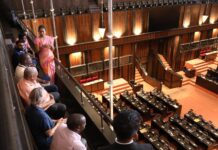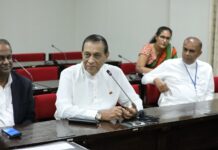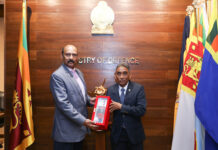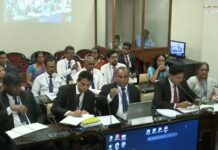Sri Lanka’s Central Bank has kept its policy rate unchanged at 6.0 per cent while market rates have started to move up in line with budget deficit and private credit, though bond and forex markets are still not fully functional.
Sri Lanka’s is facing severe external difficulties after more than a year of liquidity injections by the central bank from de facto policy rates opened through price controlled auction yields across the yield curve.
Meanwhile inflation is also moving up, partly due to a commodity bubble fired by the Federal Reserve. Sri Lanka does not have an independently floating exchange rate to ward off Fed inflation.
But its soft-peg has depreciated amid money printing, amplifying the effect.
During the year to September 2021 the rupee has fallen from around 186 to 203 to the US dollar, indicating that the currency has inflated around 9.1 per cent against the US dollar, though there is no official spot rate to compare.
Some importers however are paying higher rates.
“Inflation accelerated in recent months due to high food inflation and some acceleration in non-food inflation,” the Central Bank said.
The surge in global commodity prices prompted the Government to remove maximum retail prices on several essential commodities.
Along with resultant upward adjustments in other market prices, this is likely to cause headline inflation to deviate somewhat from the targeted levels in the near term.
The Central Bank claimed the rising commodity price was ‘supply side’.
Agriculture sector officials however are warning of supply shocks from a fertilizer ban.
Central Bank kept money markets flushed with excess liquidity until August 13, pumping hundreds of billions of rupees through failed bond auctions as money flowed out as reserve losses.
Though rates have moved up, following the lifting of price controls, bond auctions are still not fully successful though the volumes printed are smaller than earlier.
At current rates savers are also getting interested in three month bills and some money has started to shift from fixed deposits.
The Central Bank has also been buying bonds into its balance sheet, which analysts say is a questionable activity given its monetary law.
When money is printed and the credibility of the dollar peg is undermined, the government cannot generate dollars to repay debt and as the excess rupees drive excess imports, there are also forex shortages for current imports.
The Central Bank said it continued to intervene in the foreign exchange market to provide liquidity for essential imports, including fuel.
The Central Bank said it expects the external sector to strengthen with inflows. However analysts say successful bond auctions are vital to stem the excess rupees, which creates dollar shortages.
All Sri Lanka’s money supply measures are growing at double or triple digits. Reserve money or the monetary base is up 23 per cent by August despite reserve ratio cuts, M1 up 28 per cent, M2 is up 19.8 per cent.
Central Bank credit to government (printed money) which includes the result of reserve appropriations was up 187 per cent by August, credit to government from commercial banks were up 25 per cent.
The full statement is reproduced below:
The Central Bank of Sri Lanka maintains policy interest rates at their current levels
The Monetary Board of the Central Bank of Sri Lanka, at its meeting held on 13 October 2021, decided to maintain the Standing Deposit Facility Rate (SDFR) and the Standing Lending Facility Rate (SLFR) of the Central Bank at their current levels of 5.00 per cent and 6.00 per cent, respectively.
The Board arrived at this decision after carefully considering the macroeconomic conditions and expected developments on the domestic and global fronts. The Board reiterated its commitment to maintaining inflation at the targeted levels over the medium term with appropriate measures, while supporting the economy to reach its potential in the period ahead.
The global economy continues to recover
The global economic recovery is expected to continue despite large disparities across countries. As per the World Economic Outlook (WEO) of the International Monetary Fund (IMF) released on 12 October 2021, the global economy is projected to grow by 5.9 per cent in 2021 and 4.9 per cent in 2022. Economic prospects remain divergent across countries, mainly due to disparities in access to COVID-19 vaccines and policy support. Consumer price inflation in most countries increased significantly, reflecting the impact of pandemic related supply-demand mismatches and the surge in commodity prices, compared to their low base from a year ago.
The Sri Lankan economy is making headway, despite the pandemic related disruptions
As per the estimates of the Department of Census and Statistics (DCS), the Sri Lankan economy witnessed a strong recovery during the second quarter of 2021, recording a real growth of 12.3 per cent, year-on-year, following the growth of 4.3 per cent, year-on-year, in the first quarter of 2021. With the gradual return to normalcy after phasing out the COVID-19 related lockdown measures, alongside the successful rolling out of the COVID-19 vaccination programme and growth supportive policy measures, the momentum of economic activity is expected to sustain in the period ahead.
Available indicators and projections suggest that the real economy would grow by around 5 per cent in 2021, and gradually traverse to a high and sustained growth trajectory over the medium term, following near-term stabilisation measures that are being put in place by the Government and the Central Bank.
The planned coordinated efforts by the Government and the Central Bank are expected to strengthen the external sector in the period ahead
Earnings from exports marked a notable improvement and recorded over US dollars 1 billion for the third consecutive month in August 2021. Expenditure on imports has also increased, partly reflecting the surge in global commodity prices, resulting in an expansion in the trade deficit during the eight months ending August 2021, over the corresponding period of last year. Outlook for tourism improved with the easing of travel restrictions globally and the successful vaccination drive domestically.
Despite the moderation of workers’ remittances observed in recent months, a rebound is expected in the period ahead with the improved growth outlook for major foreign employment source countries and greater stability in the domestic foreign exchange market.
The realisation of foreign investments in the real sector and the timely adoption of remedial measures by the Central Bank as enunciated in ‘The Six-month Road Map for Ensuring Macroeconomic and Financial System Stability’ are gradually easing pressures in the domestic foreign exchange market.
Furthermore, the Central Bank continued to intervene in the foreign exchange market to provide liquidity for essential imports, including fuel. The depreciation of the Sri Lankan rupee against the US dollar is recorded at 6.8 per cent thus far in 2021. The Sri Lankan rupee remains largely undervalued as reflected by the real effective exchange rate (REER) indices.
In the meantime, gross official reserves were estimated at US dollars 2.6 billion by end September 2021. This, however, does not include the bilateral currency swap facility with the People’s Bank of China (PBoC) of CNY 10 billion (equivalent to approximately US dollars 1.5 billion). Gross official reserves are expected to improve with the measures that are being pursued by the Government and the Central Bank to attract fresh foreign exchange inflows, as outlined in the Six-month Road Map, thereby reinforcing the stability of the external sector in the period ahead.
Market interest rates have adjusted upwards in response to the tightening of monetary and liquidity conditions, while credit and monetary expansion remained elevated
In response to the tightening of monetary policy in August 2021, most market deposit and lending rates have adjusted upwards. Further, yields on government securities witnessed a sharp upward adjustment with the removal of maximum yield rates for acceptance at primary auctions.
Following these upward adjustments, greater stability is expected in market interest rates in the period ahead. Reflecting the increased demand for credit amidst the low interest rate environment, credit extended to the private sector expanded as envisaged during the eight months ending August 2021. The momentum of credit expansion is expected to continue during the remainder of the year, with the recovery in economic activity and continued efforts to channel credit flows to productive and needy sectors of the economy. Meanwhile, credit obtained by the public sector from the banking system, particularly net credit to the Government, also increased notably during the eight months ending August 2021. With increased domestic credit, the growth of broad money (M2b) continued to remain elevated.
Some inflationary pressures are observed, particularly due to emerging global price developments
Inflation accelerated in recent months due to high food inflation and some acceleration in non-food inflation. The surge in global commodity prices prompted the Government to remove maximum retail prices on several essential commodities. Along with resultant upward adjustments in other market prices, this is likely to cause headline inflation to deviate somewhat from the targeted levels in the near term.
While such supply side developments in the near term do not warrant monetary policy tightening, measures already taken by the Central Bank in relation to interest rates and market liquidity would help stabilise demand pressures over the medium term.
Policy rates are maintained at current levels
In consideration of the current and expected macroeconomic developments as highlighted above, the Monetary Board was of the view that the current level of policy interest rates is appropriate. The Central Bank will continue to monitor domestic and global macroeconomic and financial market developments and stand ready to take appropriate measures, as and when necessary, with the aim of maintaining inflation in the desired range under the flexible inflation targeting framework in the medium term, while supporting and sustaining the economic recovery.












